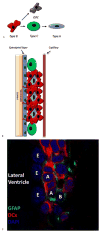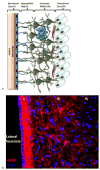The potential origin of glioblastoma initiating cells
- PMID: 22202053
- PMCID: PMC3635065
- DOI: 10.2741/S261
The potential origin of glioblastoma initiating cells
Abstract
Despite intensive clinical and laboratory research and effort, Glioblastoma remains the most common and invariably lethal primary cancer of the central nervous system. The identification of stem cell and lineage-restricted progenitor cell populations within the adult human brain in conjunction with the discovery of stem-like cells derived from gliomas which are themselves tumorigenic and have been shown to have properties of self-renewal and multipotency, has led to the hypothesis that this population of cells may represent glioma initiating cells. Extensive research characterizing the anatomic distribution and phenotype of neural stem cells in the adult brain, and the genetic underpinnings needed for malignant transformation may ultimately lead to the identification of the cellular origin for glioblastoma. Defining the cellular origin of this lethal disease may ultimately provide new therapeutic targets and modalities finally altering an otherwise bleak outcome for patients with glioblastoma.
Figures



Similar articles
-
The SVZ and Its Relationship to Stem Cell Based Neuro-oncogenesis.Adv Exp Med Biol. 2015;853:23-32. doi: 10.1007/978-3-319-16537-0_2. Adv Exp Med Biol. 2015. PMID: 25895705 Review.
-
Heterogeneity of cancer-initiating cells within glioblastoma.Front Biosci (Schol Ed). 2012 Jun 1;4(4):1235-48. doi: 10.2741/s328. Front Biosci (Schol Ed). 2012. PMID: 22652868 Review.
-
Pten and p53 converge on c-Myc to control differentiation, self-renewal, and transformation of normal and neoplastic stem cells in glioblastoma.Cold Spring Harb Symp Quant Biol. 2008;73:427-37. doi: 10.1101/sqb.2008.73.047. Epub 2009 Jan 15. Cold Spring Harb Symp Quant Biol. 2008. PMID: 19150964
-
Cancer Stem Cells: Significance in Origin, Pathogenesis and Treatment of Glioblastoma.Cells. 2021 Mar 11;10(3):621. doi: 10.3390/cells10030621. Cells. 2021. PMID: 33799798 Free PMC article. Review.
-
Side population in human glioblastoma is non-tumorigenic and characterizes brain endothelial cells.Brain. 2013 May;136(Pt 5):1462-75. doi: 10.1093/brain/awt025. Epub 2013 Mar 4. Brain. 2013. PMID: 23460667 Free PMC article.
Cited by
-
Failure of the PTEN/aPKC/Lgl Axis Primes Formation of Adult Brain Tumours in Drosophila.Biomed Res Int. 2017;2017:2690187. doi: 10.1155/2017/2690187. Epub 2017 Dec 27. Biomed Res Int. 2017. PMID: 29445734 Free PMC article.
-
Poly(ethylene glycol)-Poly(beta-amino ester)-Based Nanoparticles for Suicide Gene Therapy Enhance Brain Penetration and Extend Survival in a Preclinical Human Glioblastoma Orthotopic Xenograft Model.ACS Biomater Sci Eng. 2020 May 11;6(5):2943-2955. doi: 10.1021/acsbiomaterials.0c00116. Epub 2020 Apr 17. ACS Biomater Sci Eng. 2020. PMID: 33463272 Free PMC article.
-
Metabolic profiling of dividing cells in live rodent brain by proton magnetic resonance spectroscopy (1HMRS) and LCModel analysis.PLoS One. 2014 May 12;9(5):e94755. doi: 10.1371/journal.pone.0094755. eCollection 2014. PLoS One. 2014. PMID: 24819091 Free PMC article.
-
Advancing vaccine-based immunotherapy in glioblastoma treatment.Neurooncol Adv. 2025 Jun 24;7(1):vdaf135. doi: 10.1093/noajnl/vdaf135. eCollection 2025 Jan-Dec. Neurooncol Adv. 2025. PMID: 40756669 Free PMC article. Review.
-
Developmental Deconvolution for Classification of Cancer Origin.Cancer Discov. 2022 Nov 2;12(11):2566-2585. doi: 10.1158/2159-8290.CD-21-1443. Cancer Discov. 2022. PMID: 36041084 Free PMC article.
References
-
- Hess KR, Broglio KR, Bondy ML. Adult glioma incidence trends in the United States, 1977–2000. Cancer. 2004;101:2293–9. - PubMed
-
- Stupp R, Mason WP, van den Bent MJ, Weller M, Fisher B, Taphoorn MJB, Belanger K, Brandes Aa, Marosi C, Bogdahn U, Jr, Curschmann, Janzer RC, Ludwin SK, Gorlia T, Allgeier A, Lacombe D, Cairncross JG, Eisenhauer E, Mirimanoff RO. Radiotherapy plus concomitant and adjuvant temozolomide for glioblastoma. The New England journal of medicine. 2005;352:987–96. - PubMed
-
- Sanai N, Alvarez-Buylla A, Berger MS. Neural stem cells and the origin of gliomas. The New England journal of medicine. 2005;353:811–22. - PubMed
-
- Doetsch F. The glial identity of neural stem cells. Nat Neurosci. 2003;6:1127–34. - PubMed
Publication types
MeSH terms
Grants and funding
LinkOut - more resources
Full Text Sources
Other Literature Sources
Medical

